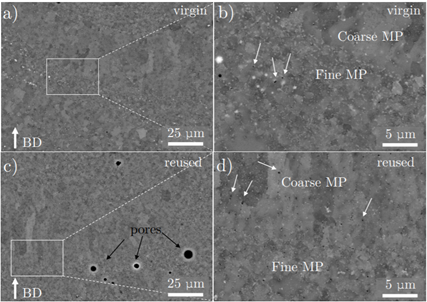According to University of Twente PhD candidate Laura Cordova Gonzalez, metal powders used in additive manufacturing can be safely reused. This enables the reduction of waste in the production of many functional parts for application in the aerospace, biomedical, energy and automotive industries.
In order to reduce the downtime of vehicles or other machines, most companies make use of a lot of spare parts. This process needs a lot of space and not all stored parts are getting used. By using additive manufacturing, also known as 3D-printing, it is no longer needed to stock spare parts as they can be produced on demand.
Reusing metal powder
Only a small proportion of the metal powder used in additive manufacturing is melted into a part. After printing, the excess powder is removed from the final product and may be stored for later use but too little is known about the quality of this excess powder. The printing and the storing can both contaminate the powder and change its properties making it unreliable. Reusing the powder is a risk most companies are not willing to make. “In most critical components, like in the aerospace industry, it is important that the metal powders, and therefore the final products, maintain their quality and present a high degree of repeatability”, says Cordova Gonzalez.
Figure 1 Micro pores in parts made from unused 'virgin' powder (a and b) and reused powder (c and d)
Changed structure
In her thesis, Cordova Gonzalez describes a methodology to safely reuse metal powder for selective laser melting. In her research, she looked at four different metal powder commonly used in additive manufacturing. All these powders had different properties after several cycles of reuse, as she says: “Parts built with reused powder show greater micro-sized porosity than parts made from new powder after four cycles of reuse.” However, the changed structure (see figure 1) had no effect on the mechanical properties in static loading.
New Methodology
To ensure powder quality Cordova Gonzalez proposes a new methodology for both reusing and storing powder. She advises to analyzing powder before the first usage, after prolonged storing periods and in between cycles depending on the needed reliability of the endproduct. To increase the quality of the used powder, manufacturers can sieve the powder to remove too large particles or rejuvenate the powder by mixing it with new, unused powder.





